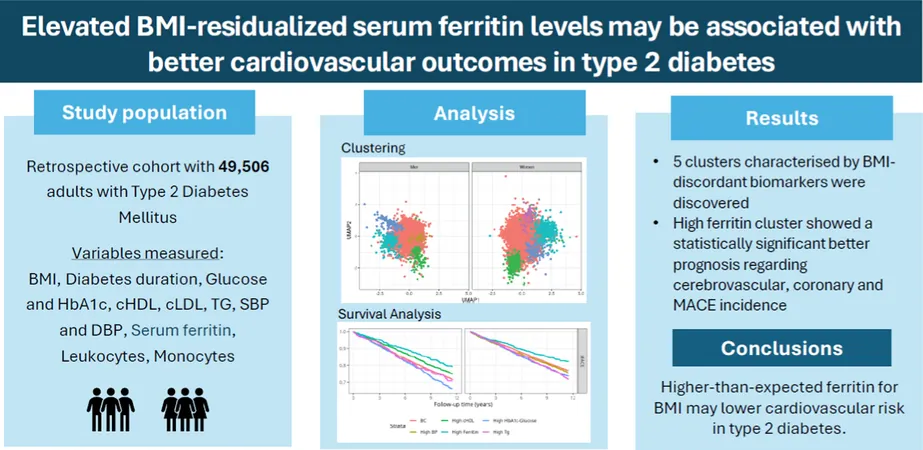
Unraveling the Hidden Link Between Ferritin Levels and Cardiovascular Protection in Type 2 Diabetes Patients
2025-03-26
Author: Yu
Introduction
In the battle against type 2 diabetes (T2D), understanding the connections between various biomarkers and cardiovascular outcomes can be a game-changer. Recent research focused on serum ferritin levels—a protein that stores iron in the body—has unveiled a surprising finding: certain individuals with elevated ferritin levels relative to their body mass index (BMI) appear to enjoy a protective effect against cardiovascular disease. This discovery holds potential implications for risk assessment and treatment strategies for millions living with T2D.
Study Overview
This groundbreaking retrospective cohort study involved the analysis of data from a staggering 49,506 individuals diagnosed with T2D, sourced from a comprehensive primary care registry in Catalonia, Spain. Participants, ages 35 and older, were recruited between January 2010 and December 2021 and closely monitored for a minimum of ten years.
The researchers scrutinized a range of cardiovascular risk markers, including serum glucose, HbA1c levels, cholesterol fractions, blood pressure readings, and serum ferritin, alongside white blood cell counts. By employing a sophisticated clustering analysis, the team was able to categorize patients into distinct subgroups based on their risk profiles for major adverse cardiovascular events (MACE).
Key Findings
The study identified five unique clusters characterized by differing levels of biomarkers, most notably serum ferritin. Interestingly, individuals presenting discordantly high ferritin levels relative to their BMI demonstrated lower risks for adverse cardiovascular outcomes. Specifically, men in this group showed a hazard ratio (HR) of 0.68 for cerebrovascular events and 0.65 for coronary events, indicating a significant reduction in risk. Women exhibited similar protective benefits with HRs of 0.81 and 0.73, respectively.
These results challenged prevailing assumptions about ferritin levels, suggesting that they may be more nuanced in their relationship with cardiovascular risk than previously thought and revealing new avenues for risk stratification in T2D management.
Why Ferritin Matters
Ferritin's role transcends simple iron storage, as its elevation often signals an inflammatory response. This underscores the complexity of interpreting ferritin levels, which could be influenced by underlying health conditions, including chronic inflammation or infection. What's vital here is that high ferritin levels—when viewed alongside BMI—may contribute positively to a person’s cardiovascular health.
Moreover, exploring the influence of oxidation and inflammation on cardiovascular conditions establishes a critical context for understanding why certain subgroups of T2D patients experience varied health outcomes.
The Bigger Picture: Obesity, Diabetes, and Iron
Understanding T2D's links to obesity provides further insight into these findings. While increased BMI is a well-documented risk factor for developing Type 2 diabetes, emerging research indicates that high ferritin levels often accompany obesity. Studies have shown that elevated BMI can alter iron metabolism, leading to increased ferritin levels even in the absence of overt iron overload.
However, a crucial question arises: Do these elevated ferritin levels confer a protective benefit, or do they merely reflect an underlying metabolic issue? This study leans toward the former, suggesting a potential mechanism wherein higher ferritin may help buffer oxidative stress—thereby diminishing cardiovascular events.
Conclusion
The implications of this research extend far beyond academic curiosity. As healthcare systems grapple with the rising rates of type 2 diabetes and related cardiovascular diseases, identifying subpopulations who can benefit from refined treatment strategies is essential. This study's revelation that higher-than-expected ferritin levels can indicate a lower risk for cardiovascular complications paves the way for new approaches in managing diabetic patients.
Ultimately, it calls for a reconsideration of existing guidelines that have dominated diabetes care for years. As we chase the next breakthrough in diabetes management, understanding the intricate balance between ferritin and BMI will be key in improving patient outcomes and preventing the perilous cycle of cardiovascular disease amongst those with type 2 diabetes.
Call to Action
The study emphasizes the necessity for further research to unearth the underlying biological mechanisms linking elevated ferritin levels with cardiovascular health. As the medical community strives to enhance patient care, these insights could lead to innovative strategies that optimize treatment options for individuals battling type 2 diabetes. The message is clear: we must rethink the way we view ferritin in the context of diabetes—it's not just about iron, it's about life-saving potential.

 Brasil (PT)
Brasil (PT)
 Canada (EN)
Canada (EN)
 Chile (ES)
Chile (ES)
 Česko (CS)
Česko (CS)
 대한민국 (KO)
대한민국 (KO)
 España (ES)
España (ES)
 France (FR)
France (FR)
 Hong Kong (EN)
Hong Kong (EN)
 Italia (IT)
Italia (IT)
 日本 (JA)
日本 (JA)
 Magyarország (HU)
Magyarország (HU)
 Norge (NO)
Norge (NO)
 Polska (PL)
Polska (PL)
 Schweiz (DE)
Schweiz (DE)
 Singapore (EN)
Singapore (EN)
 Sverige (SV)
Sverige (SV)
 Suomi (FI)
Suomi (FI)
 Türkiye (TR)
Türkiye (TR)
 الإمارات العربية المتحدة (AR)
الإمارات العربية المتحدة (AR)